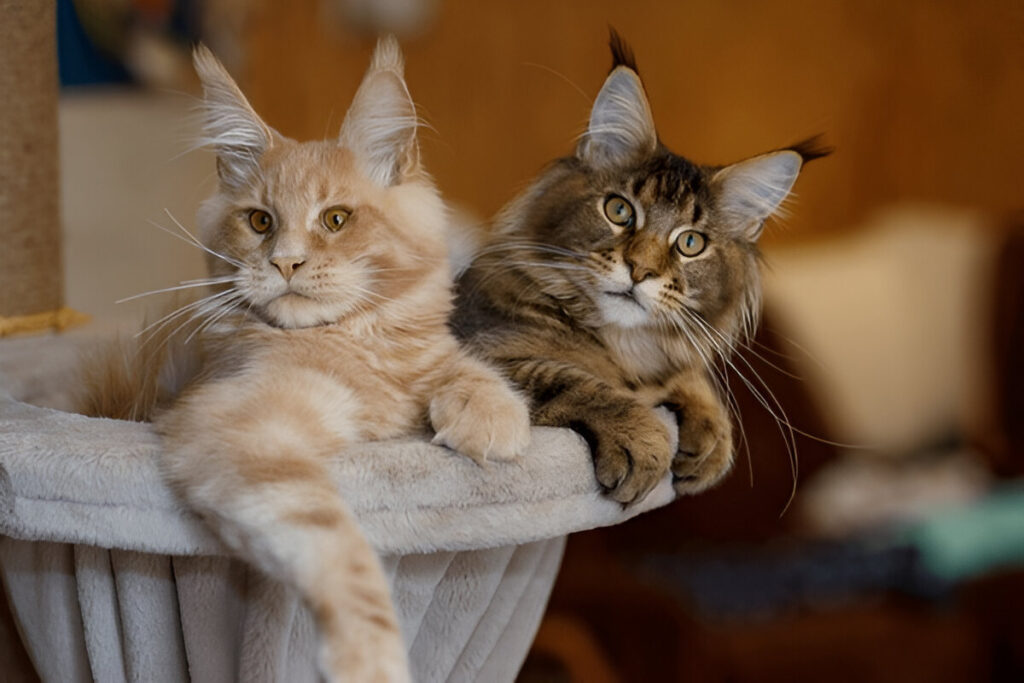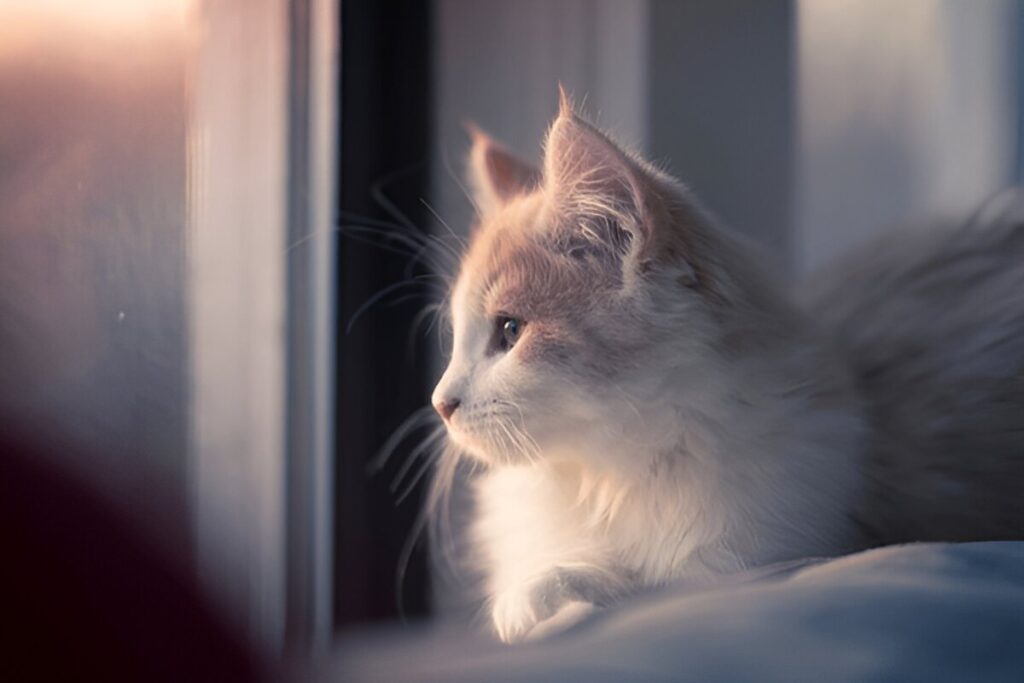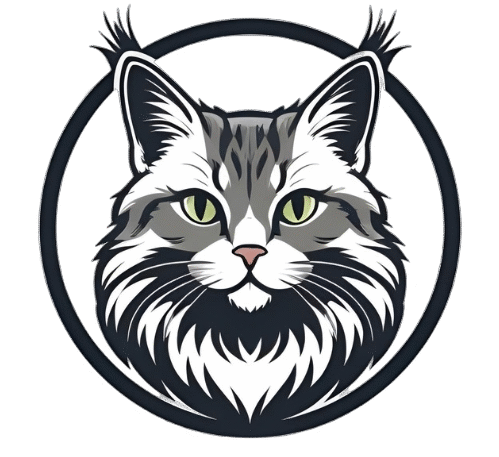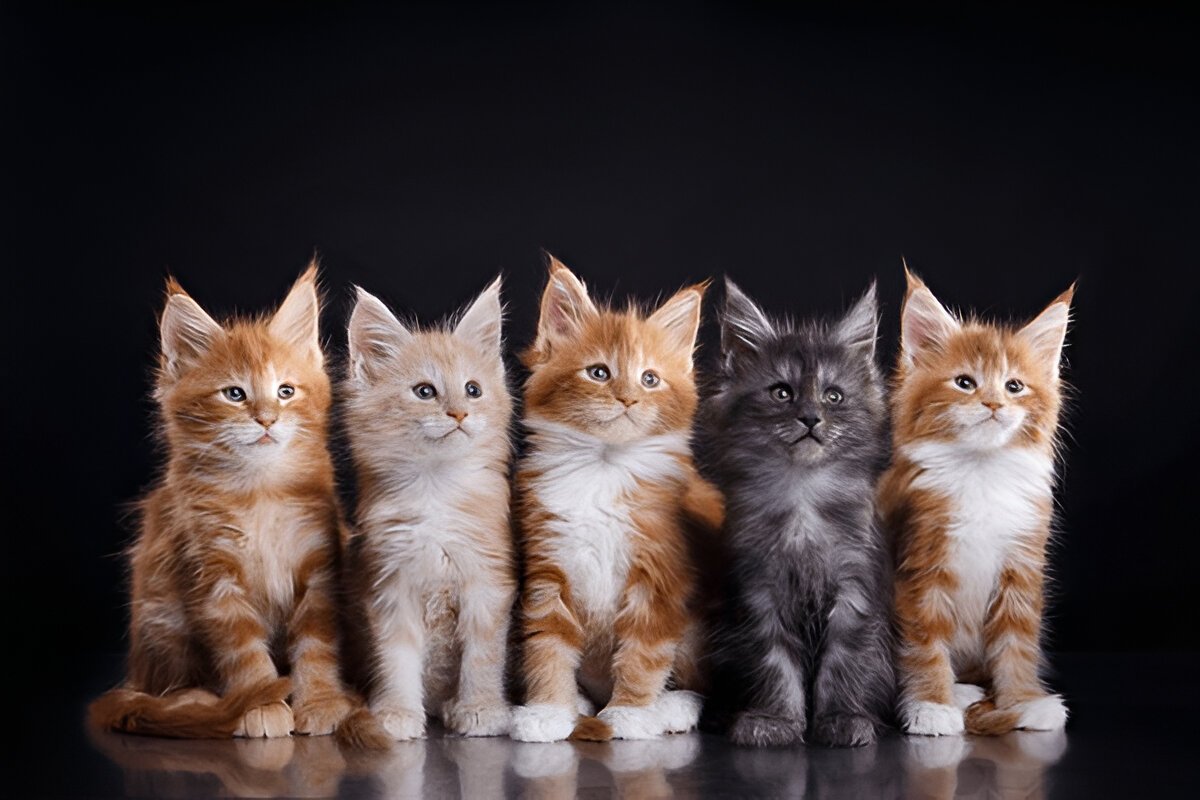Maine Coons are like the rock stars of the feline world, big, friendly, and crazy unique. One of the best things about this breed is the color and coat pattern options available to you with a Maine Coon.
If you are a fan of the striking Maine Coon breed, you will be excited to learn about the variety of Maine Coon cats colors and patterns!
What is your favorite Maine Coon colors and pattern?
If you are getting a Maine Coon or curious, it’s amazing how many looks Maine Coons have. There are over 75 recognized colors and coat patterns recognized by major cat registries like the Cat Fanciers’ Association (CFA) and The International Cat Association (TICA).
Let’s discover the exciting colors that make Maine Coons so unique!
Tabby vs. Solid Maine Coon Cats
Solid Maine Coon Cats
- Definition: Solid Maine Coons have a coat with one uniform color, where no stripes, spots, or swirls are visible.
- Appearance: Their fur is all one shade, except for red solid cats, which may show some faint tabby markings about the red gene.
- Rarity: Solid Maine Coons are less common. This is because solid is a recessive gene. You must breed two solid parents to make a solid kitten.
Tabby Maine Coon Cats
- Definition: Tabby is a coat pattern, not a breed. Every tabby will have the characteristic “M” marking on its forehead, and they will also have stripes, swirls, and/or spots on their bodies.
- Patterns: Common tabby patterns in Maine Coons include classic (blotched), mackerel (striped), spotted, and ticked.
- Appearance: Tabby Maine Coons are much more common than solid Maine Coons because tabby is the dominant gene. Tabby Maine Coons fur around their eyes, chin, and ear edges will be lighter than the rest. Their legs will have stripes.
- Colors: Tabby Maine Coons can come in all colors: brown, red, silver.

What Solid Colors Do Maine Coons Come In?
Maine Coons can have so many different colors. A solid Maine Coon has one color of a uniform shade from head to tail without stripes, spots, or breaks in color.
Here is a more in-depth look at the solid Maine Coons:
Solid Colors in Maine Coon Cats
Black
Solid Black Maine Coons are one of the most common types of solid colors. They have a deep, coal black color from root to tip with no light or pattern from pattern discrepancies.
The nose on black Maine Coons is black and the paw pads may be black or dark brown. The sleekness and deep color all contrast nicely to produce a striking and elegant Maine Coon.
White
White Maine Coons are pure from nose to tail so you can see the glistening coal white from the tip of one length of the fur to another.
The white paw pads are pink in color, in contrast to the coat color. While the genetic definition of white is the absence of color, visually, it can be obvious that white represents its solid color.
Blue
Blue Maine Coons are actually a soft, sophisticated shade of gray with a hint of blue—not blue, as the name might suggest. Their body color, nose leather, and paw pads are all the same color, offering a cool, elegant appearance. However, blue is a rarer solid color in the breed.
Cream
Cream Maine Coons have a light buff cream-colored coat across the body. Their nose leather and paw pads are pink, like the white Maine Coons. This gentle, light warm colour may be less common than black or white, but it is equal in beauty.
Red
Red Maine Coons are often referred to as ginger or orange. Red Maine Coons have a brassy red coat, and their nose leather and paw pads are the same body color.
True solid red is rare due to genetics, since there’s a history of almost all red cats exhibiting some degree of tabby patterning with the gene variant.
However, some breeders, given that the tabby patterning is minimal or subtle, refer to the Maine Coons as solid.

Common Color Patterns in Maine Coons
Maine Coon cats are famous for their lavish coats, which exhibit a beautiful array of patterns. These patterns not only serve to enhance the breed’s inherent beauty, but they also create a form of wonder and uniqueness.
Below, you will find an elaboration of all the patterns of coats found in Maine Coons based on verified, breed standard information.
Major Maine Coon Coat Patterns
Tabby Patterns
Tabby is the most well-known and the most frequent pattern associated with Maine Coons. There are three main types of tabby patterns:
- Classic Tabby: The classic tabby has bold swirls on the sides with circular spots that often look bullseye or target-shaped, a butterfly-shaped marking on the shoulders, and vertical lines from the head to the shoulders. Classic tabbies have the signature “M” marking on their foreheads.
- Mackerel Tabby: The mackerel tabby exhibits thin vertical stripes on both sides, similar to a fish bone. They are also usually thinner and more uniform than the classic tabby.
- Ticked Tabby: The ticked tabby does not have stripes or swirls, but instead has each hair banded with different colours, creating a salt and pepper appearance. Stripes may present on the legs, tail, and/or face, but they will look more “ticked” or flecked as a whole.
Tabby with White
This pattern consists of any tabby type plus white areas (mainly on the chest, belly, paws, and sometimes face). The white markings offer a really nice contrast with the Tabby patterns, and make these cats particularly striking!
Bi-Color
Bi-color Maine Coons have a coat that is primarily one color (black, blue, red, and cream) with white. The white occurs on the belly, chest, paws, and sometimes on the face.
The most common bi-color combinations typically include black and white, blue and white, red and white, and cream and white.
Parti-Color
A parti-color Maine Coon would have a mixing color, but blue and cream are the only exceptions. The most recognized parti-colors include the following:
- Tortoiseshell: A mixture of black and red (or their diluted forms, blue and cream) usually in a type of patchwork or brindled pattern. Tortoiseshells can show tabby markings referred to as “torbies”.
- Blue-Cream: A mix of blue (diluted black) and cream (diluted red), with the same patchwork effect as tortoiseshells.
Parti-Color with White
These cats combine the parti-color patterns (i.e., tortoiseshell or blue-cream) with white markings often on the chest, belly, and paws to increase dramatic appeal.
Shaded and Smoke Patterns
- Shaded: The undercoat is a lighter color than the overcoat, creating that gradient or shaded look. The shaded silver Maine Coons have white undercoating with dark and lighter tipped hair giving it a silvery look.
- Smoke: The coat may appear solid initially, but you can see the undercoat is lighter when you part the hair. All solid colors (except the color point) can have smoke versions, including tortoiseshell smoke. The smoke effect becomes more distinct as the cat matures.

Rare Maine Coon Colors and patterns
While the majority of Maine Coons you’ll see are brown tabby, black, white, blue, and cream – and several of these are quite rare – knowing about these colors may actually enhance your appreciation of the breed.
Silver and Golden Maine Coons
Silver and golden Maine Coons are discoverable by their shiny coats. Silver Maine Coons are uniquely colored due to a pigment inhibiting gene that inhibits the yellow pigment in brown and black Maine Coons.
Conversely, golden Maine Coons are yellow because they have a gene that intensifies yellow pigment. Both colorations could be expressed in various patterns.
Chocolate and Lilac Variations
Chocolate and lilac Maine Coons are rare and found with specific genes that allow their colors to appear. Chocolate Maine Coons have a warm brown color due to the dilution of the black pigment. Lilac Maine Coons have a paler silvery-gray color with a pinkish hue because of genetic delusions.
Color-Pointed Maine Coons and Breed Recognition
Color-pointed Maine Coons exhibit a similar style to the Siamese breed, with lighter bodies and darker points. We don’t always see this pattern acknowledged by the usual breed standards because it adds further variety to the breed.
Some important features to remember when considering the color genetics of the Maine Coon include:
- Involvement of several genes in obtaining the final coat color and pattern.
- Involvement of genetic dilution to produce the rare colors of lilac and chocolate.
- Temperature-sensitive enzymes produce color-pointed patterns.
These variables around determining the color of your Maine Coon can promote a better appreciation for their uniqueness.
How Do Maine Coons Get Their Colors? (A Little Science)
All cat colors come down to two basic colors: black and red. Everything else is just a twist on those, like blue (dilute black) or cream (dilute red). White isn’t really a color—it’s just the absence of color, like a white coat covering up the real color underneath.
Patterns are controlled by different genes. For example, the tabby gene gives you stripes or swirls, and the solid gene gives you one color all over. The silver and gold colors come from a special “inhibitor” gene that changes how the color looks in the undercoat.
What Do Maine Coon Kittens Look Like?
Maine Coon kittens can look totally different from their parents. Their colors and patterns get clearer as they grow. When they’re born, their fur is usually darker and their eyes are blue. As they get older, their eyes change to gold, green, or copper, and their fur can get lighter or darker depending on the season and their genes.
You can sometimes guess what a kitten will look like as an adult by looking at their paw pads and nose—dark pads usually mean a darker coat, while pink pads mean a lighter coat.
Choosing a Maine Coon: Does Color Matter?
Many people are drawn to certain colors or patterns, but the reality is that Maine Coons are awesome regardless of how they look. Their true essence, personality, and temperament are not inhibited by color—they are all friendly, smart, and playful.
- Personal Preference: Select the colors and patterns that you like best. There are no right or wrong choices.
- Health and Genetics: There are no good or bad health matters on color. To guarantee healthy genetics, you can always buy from a responsible and reputable breeder.
- Show Standards: If you are going to show your cat, double-check what colors or patterns are approved by the recommending associations.
Finally, if you decide to purchase from a breeder, colors/patterns like gold, silver, or calico will most often increase the purchase price.
Below is an estimate of what you may way for a Maine Coon, basing costs on color/pattern (of course, prices vary because of the breeder and location):
Maine Coon Price Based on Color and Pattern
| Color/Pattern | Typical Price Range (USD) | Notes |
| Brown Tabby | $1000–$2,000 | Most common, classic look |
| Black/Blue | $1000–$2,500 | Blue is a dilute black |
| White | $1,000–$2,500 | A mix of black and red patches |
| Tortoiseshell | $1,000–$2,200 | Mix of black and red patches |
| Calico | $1,200–$2,500 | Black, red, and white patches |
| Smoke | $1,200–$2,500 | Dark tips, light roots |
| Silver/Gold | $1,500–$3,000+ | Rare, highly sought after |
Prices are estimates and can vary widely. Always check with reputable breeders.
Conclusion
Maine Coons are available in so many colors and patterns, ranging from the original brown tabby to rare gold and silver, and everything in between and beyond. No matter whether you prefer a solid black, calico, or smoky blue—in terms of color, there is a Maine Coon for every preference and style.
Certainly rarer colors will cost more to purchase, but each Maine Coon has its own personality and life presence. If you are considering bringing one into your family, enjoy the hunt for theirs, and enjoy the journey to meet it!
FAQs:
What is the most common Maine Coon color?
Brown tabby is the most iconic, but solid black and classic tabby patterns are also common.
Can Maine Coon kittens change color as they grow?
Yes, some kittens’ coats get darker or develop new patterns as they get older.
Do certain colors have more health problems?
Not usually, but all Maine Coons should be screened for breed-specific conditions.
How do I care for a Maine Coon’s coat, no matter the color?
Brush them regularly, bathe them if they get dirty, and watch out for mats or oily fur.
What is a torbie?
A tortoiseshell cat with stripes—kind of like a two-for-one special.
References:
1. https://cfa.org/coat-color-descriptions/
2. https://tica.org/breed/maine-coon/
3. https://pmc.ncbi.nlm.nih.gov/articles/PMC8423757/
4. https://a-z-animals.com/pets/cats/cat-lists/maine-coon-cat-colors/

